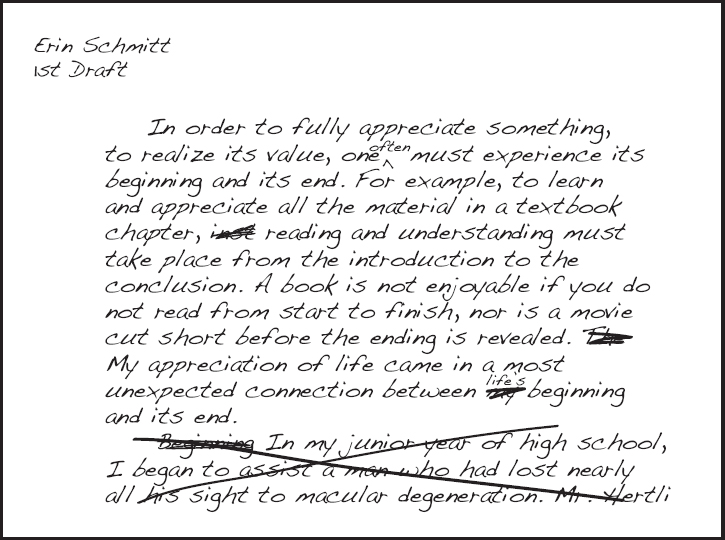Planning, Drafting, and Developing
When Erin looked over her notes, she realized that she could easily organize her ideas in a logical sequence: first introduce the experience and its importance, next present events in chronological order as they had happened, and then return to their importance.
 What organization would suit your needs?
What organization would suit your needs?
Assisting Mr. Hertli → Last time assisting Mr. Hertl → Reading atlas → Young and old → Appreciation of life
 How are you starting your draft? What process works for you?
How are you starting your draft? What process works for you?
Once Erin had a rough structure for her essay, she was ready to start developing her ideas. Between classes, she started drafting her first version by hand, following her plan but concentrating on getting ideas on the page. She crossed out false starts, including her original second paragraph. She inserted words as she thought of them and crossed some out. After all, she didn’t care whether this draft was messy because she would clean it up when she keyed it on the computer.

See Peer Response questions for Erin’s assignment.
Erin typed her rough draft, including all her handwritten changes, to get it ready for other readers. She and her classmates were going to exchange papers during a workshop for peer response. Erin expected her classmates to ask about anything that wasn’t clear and to respond to the peer response questions for the assignment. Erin also wanted their advice about her own questions:
 What do you want to ask your readers?
What do you want to ask your readers?
- Is the scene I’m recalling clear? Does it come alive when you read it?
- Do I reflect enough? Should I add more about my insight?
Erin’s instructor also required a conference about the draft to discuss revisions that might improve the final version. Erin expected her suggestions to concentrate on the criteria for the assignment: a clear experience with reflection about its significance for the writer. Both sets of comments — handwritten notes and highlighting from a fellow student and electronic “balloons” from her instructor — are shown next to Erin’s rough draft.